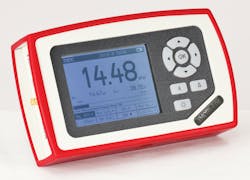PRODUCT FOCUS: LASER POWER AND ENERGY METERS: How to select a power and energy meter
Power and energy meters measure the output of an optical source. They are a necessity in a wide variety of applications in the lab, on the production floor, or in the field, whether the emission is from low-light sources, such as fluorescence, or from high-energy pulsed lasers.
Although power meters and energy meters are available separately, they have also converged as single category instruments—power-and-energy-meters or PEMs—with the development of versatile consoles or displays that can adapt to a variety of different types of optical sensors. The type of sensor determines whether the device measures optical power or energy, typically in watts or joules, respectively. By itself, a power meter measures either continuous wave (CW) or repetitively pulsed sources, and the typical sensors would be either thermopile or photodiode. An energy meter typically measures pulsed lasers, either single or repetitive pulses, and sensors would include pyroelectric, thermopile, or photodiode with circuitry specially designed to measure pulses.
System configuration
Some manufacturers distinguish between the meter part of the device (or console), which has the controls and readout, and the sensor part (also called detector or head). Combining them creates a "measurement system." Other vendors call both of them together a meter. Either way, the sensor stores the calibration information and the console measures the output current from the sensor, and references that to a calibration chart to output the data.
On some units, the console, which is the interface between the detector and the user, will send measurements directly to a computer via RS-232 or USB connections, in which case a display may not be necessary. Measurements might include a graph of the power, difference, sum, linear, and log values, and attenuation of more than one channel simultaneously. Most PEM consoles are digital, but for applications with only small fluctuations in power, an analog meter suffices.
Sensors are the tricky part. The three main types of sensors on the market are photodiode, thermal, and pyroelectric. According to Christian Johns, project manager at Thorlabs (Newton, NJ), photodiode sensors consist of a photodiode, typically silicon (Si), germanium (Ge), or indium gallium arsenide (InGaAs)—each with different peak wavelength-range responses—and a neutral density (ND) filter to ensure that the power incident on the detector allows the sensor to operate linearly. Each diode, even of the same material, has a different responsivity versus wavelength profile. Responsivity is measured in A/W and is a measure of how efficiently the sensor converts incident light to current. Sensors with fast response times are wavelength sensitive and so work best for smaller, low-power lasers.
Thermal sensors convert incident light into thermal energy for measurement of power or energy, says Johns. These are spectrally flat from about 186 nm to 10.6 μm so are useful for multiple wavelengths or non-monochromatic light. Photodiodes also can measure wavelengths from the ultraviolet (UV) to infrared (IR), but they have a different response at different wavelengths, so the wavelength of the laser beam must be entered into the meter to get the correct reading. At wavelengths of 1800 nm or higher, a thermal detector is typically the only choice. Thermal sensors can withstand high-power lasers but they take a few seconds to reach equilibrium if there is a large power swing. They also don't work as well for low power levels because they are not as sensitive as a photodiode.
Pyroelectric energy sensors measure pulsed energy by converting the energy from a light pulse into a voltage spike. They are responsive across a wide range of wavelengths but are not as spectrally flat as thermal sensors. They also work only with pulsed sources and have minimum bandwidth requirements to enable a sensor to "see" the pulse.
"Many power and energy meters on the market today are compatible with all three types of sensors," says Johns (see Fig. 1). "If you use one of these versatile consoles with a power sensor, the proper nomenclature would be power meter. If you use it with an energy sensor, it's an energy meter."
Which sensor?
It helps to understand which types of sensors may be used for measuring power, which for measuring energy, and over what range of measurements. Don Dooley, general manager at Gentec-Electro-Optics USA, formerly president of Spectrum Detector (Lake Oswego, OR), recently acquired by Gentec-EO, says thermopile detectors used to measure power tend to be large in area, have a high damage threshold, and can measure power at levels from milliwatts to kilowatts. Semiconductor-based photodiode detectors tend to be small but sensitive, measuring from picowatts to milliwatts.
All three types of detectors can measure energy. Thermopile detectors are ideal for millisecond-range single-pulse measurements or highly energetic beams of several joules per pulse. Pyroelectric detectors work best for short pulses (femtosecond to millisecond) and broad energy range (50 nJ up to joules). Photodiode detectors can measure short pulses (femtosecond to microsecond) with low energy (femtojoules to microjoules). "Performance ranges for the key specifications vary dramatically with each model probe and instrument," says Dooley. "Working with a product specialist in advance is always a good idea."
According to Paul Tozer, managing director at Lasermet (Bournemouth, England), photodiode detectors may come with an integrating sphere for uniform and accurate measurement of light. Lasermet photodiode heads with an integrating sphere can typically measure down to 1 μW and compact heads where the beam is targeted directly on the photodiode can measure down to around 1 nW (see Fig. 2). Thermal heads can typically measure down to 1 mW.As for higher-power sources, photodiode heads at Lasermet can typically measure to 1 W max, says Tozer—higher if filters are used to cut out 90 or 99% of the beam (although these cause reflections and can introduce inaccuracies). Thermal heads can measure up to 20 W; specialty thermal heads are available for 100 W or even multikilowatt lasers.
Photodiodes have the fastest response rate. "The IPDH-10S and IPDH-10C when connected to the ADM-1000 have a frequency response of 400 kHz. This is approximately 1000 times faster than anything else on the market," says Tozer. Such responsivity allows single-pulse waveforms to be isolated and displayed and the energy within a single pulse measured.
Photodiodes also offer higher thermal stability, whereas thermal detectors are subject to thermal interference and drift and are therefore more difficult to use correctly, says Tozer. Some thermal detectors incorporate temperature stabilization features that greatly reduce drift.
Key specs
Jay Jeong, senior product marketing manager of Photonics Instruments at Newport (Irvine, CA), says the first specifications to consider when choosing a PEM are the wavelength range and the measurement range in watts or joules of the sensor. "The meter should be able to interpret the values without saturation," says Jeong. Typical saturation current is on the order of 10 mA (approximately 10 mW power at peak responsivity). High-power measurements typically use integrating spheres or optical attenuators to reduce saturation. Another important spec for a system is the signal-to-noise level of the minimum detectable power/energy level. Typical noise level is on the order of a few milliwatts, and the high sensitivity models can measure down to 1 μW.
Gary Wagner, president, Ophir-Spiricon Inc. (OSI; Logan, UT), agrees. After you pick the appropriate sensor to measure your laser or broadband source, the damage threshold is the next concern. "You need to know your power or energy density to protect the sensor from damage," says Wagner. That requires knowing your beam spot size, and the energy distribution. A Gaussian beam has much higher density at the peak of the beam.
For pulsed lasers, says Wagner, the pulse length is a key consideration. Most sensors have a different damage threshold value based on peak power; a short pulse with the same amount of energy per pulse will give a much higher peak power and will more readily damage the sensor. For applications above the damage threshold, attenuation options include beamsplitters, diffusers, ND filters, and measuring the leakage through a mirror.
The operating ranges for the key specifications vary dramatically with each model probe and instrument. The key is to match your laser or source output specifications to the detector and instrument specifications, which should exceed those of the laser.Another key spec is uncertainty, which is related to accuracy and consistency. Most companies calibrate their working standards from those set by the National Institute of Standards and Technology (NIST; Boulder, CO and Gaithersburg, MD), which provides an uncertainty based on a standard physical constant, such as the temperature rise in water. Errors in the accuracy specification should be published in a percentage for each sensor and display (see Fig. 3).Tradeoffs
Tradeoffs abound when selecting a PEM. For example, if you need to measure a high-power laser with a small diameter beam, you'll need a probe that has a high damage threshold. A PEM with a high damage threshold will not be very sensitive so it isn't possible to read extremely high and low powers with the same probe. The same goes for the higher readings of an energy detector. "Also, some specialized products can measure, for example, high energies per pulse," says Dooley, "but they will do it at low rep rates, thus not at high powers."Though PEMs have been around a long time, new advances in laser and terahertz source technology have created new measurement challenges that require unique sensors and instruments. "Since the development of high-rep-rate DPSS and fiber lasers, the laser industry has had a difficult time testing and controlling pulsed lasers running at up to and over 100 kHz," says Dooley. "Mach 5 is the first and only digital joulemeter that addresses this need" (see Fig. 4).
Editor's note: The "Product Focus" series is intended to provide a broad overview of the product types discussed. Laser Focus World does not endorse or recommend any of the products mentioned in this article.

Valerie Coffey-Rosich | Contributing Editor
Valerie Coffey-Rosich is a freelance science and technology writer and editor and a contributing editor for Laser Focus World; she previously served as an Associate Technical Editor (2000-2003) and a Senior Technical Editor (2007-2008) for Laser Focus World.
Valerie holds a BS in physics from the University of Nevada, Reno, and an MA in astronomy from Boston University. She specializes in editing and writing about optics, photonics, astronomy, and physics in academic, reference, and business-to-business publications. In addition to Laser Focus World, her work has appeared online and in print for clients such as the American Institute of Physics, American Heritage Dictionary, BioPhotonics, Encyclopedia Britannica, EuroPhotonics, the Optical Society of America, Photonics Focus, Photonics Spectra, Sky & Telescope, and many others. She is based in Palm Springs, California.



